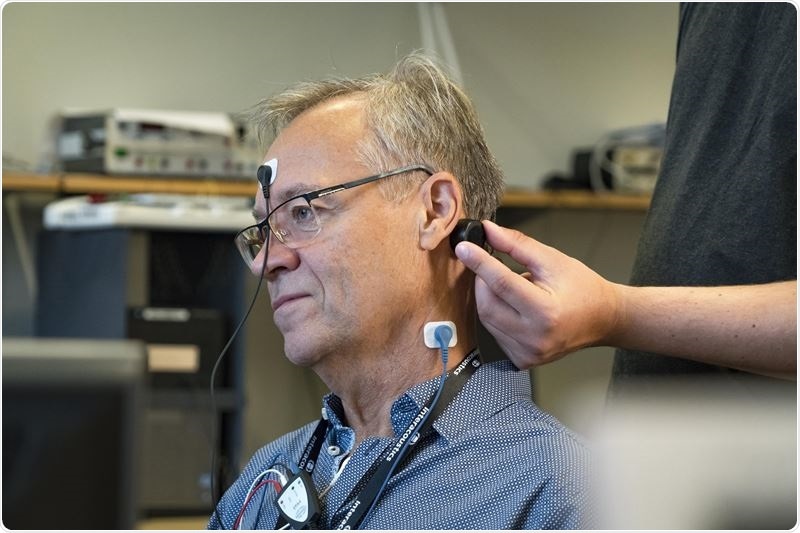Patients with dizziness problems can now get better diagnosis in a simple and painless way. A new type of bone conduction speaker, easily attached behind the ear, can make the diagnosis more efficient and safer – especially for patients who also suffer from hearing problems. The technology has been developed by researchers at Chalmers University of Technology, Sweden, and is now ready for manufacturing.

Bo Håkansson, Professor of Electrical Engineering, undergoes testing using the new compact vibrating device he and the team helped design. Photographer: Johan Bodell / Chalmers University of Technology
Hearing and balance are closely related. For patients with dizziness, this relationship is used for diagnosis. Commonly, a ‘VEMP’ test (Vestibular Evoked Myogenic Potentials) is performed. A VEMP test uses loud sounds to evoke a muscle reflex contraction in the neck and eye muscles, triggered by the vestibular system – the system responsible for our balance. Instead, the Chalmers University researchers are using bone-conducted sounds to achieve better results.
"We have developed a new type of vibrating device called B250 that is placed behind the ear of the patient during the test," says Bo Håkansson, a professor in the research group 'Biomedical signals and systems' at Chalmers. “The vibrating device is small and compact in size and optimized to provide an adequate sound level for triggering the reflex at frequencies as low as 250 Hz, which we have found to be optimal for VEMP stimulation. Previously, no vibrating device has been available that was directly adapted for this type of test of the balance system.”
In bone conduction transmission, sound waves are transformed into vibrations through the skull, stimulating the cochlea within the ear, in the same way as when sound waves normally go through the ear canal, the eardrum and the middle ear. This can be used in various technologies, and Bo Håkansson has over 40 years of experience in this field – he has previously developed hearing aids using this technology.
Dizziness a common problem in older patients
Half of over-65s suffer from dizziness, but the causes can be difficult to diagnose for several reasons. In 50% of those cases, dizziness is due to problems in the vestibular system. But today's VEMP methods have major shortcomings and can cause hearing loss and discomfort for patients. The VEMP test uses very high sound levels and can in fact cause permanent hearing damage itself. And, if the patient already suffers from certain types of hearing loss, it can sometimes be impossible to draw any conclusions from the test.
" The previous test was like a machine gun going off next to the ear – with this bone-conduction method it will be much more comfortable. The sound levels to which patients are exposed can be minimized. The test can be performed at 40 decibels lower than today's method, which uses air-conducted sounds through headphones. This eliminates the risk that the test itself could cause hearing damage,” says researcher Karl-Johan Fredén Jansson, who made all the measurements in the project.
The benefits also include safer testing for children, and that patients with impaired hearing function due to chronic ear infections or congenital malformations in the ear canal and middle ear can still be diagnosed for the origin of their dizziness.”
Bo Håkansson, Chalmers University of Technology
A prototype of the vibrating device was first developed by the researchers in 2018, and it has now been tested and developed in several patient studies that have been published internationally, both with healthy individuals to obtain normal data, and in patients suffering from various types of dizziness. The device is compatible with standardized equipment for balance diagnostics in healthcare, which makes it easy to use. In addition to the benefits for patients, the cost of the new technology is also judged to be lower than the corresponding equipment used today, and discussions are ongoing with companies wishing to commercialize the technology.
Source:
Journal reference:
Plontke, S.K., et al. (2021) A case series shows independent vestibular labyrinthine function after major surgical trauma to the human cochlea. Communications Medicine. doi.org/10.1038/s43856-021-00036-w.